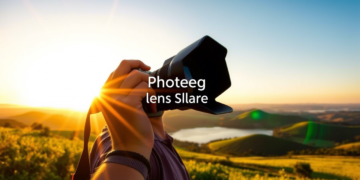Photeeq lens flare is the educational content and practical advice on lens flare provided by Photeeq, a platform dedicated to photography and videography. Lens flare is an optical phenomenon where stray light enters the camera lens, scattering and reflecting to create visible photo artifacts, such as circles, haze, or starburst patterns. This effect often occurs when shooting towards bright lights like the sun.
Causes and Management
Lens flare can result from bright light sources, the lens’s design and quality, or dust on the lens. To reduce it, photographers can use a lens hood, clean the lens regularly, adjust the camera angle to avoid direct light, and shoot during less intense light times, like early morning or late afternoon. Photeeq likely emphasizes these practical tips to help photographers control unwanted flare.
Creative Uses
Lens flare isn’t always a problem; it can be a creative tool. Photographers might use it to add drama, highlight subjects with a halo effect, or simulate atmospheric conditions like fog. Photeeq encourages this artistic approach, offering inspiration and examples for using lens flare in professional work.
Survey Note: Detailed Exploration of Photeeq Lens Flare
This section provides a comprehensive analysis of photeeq lens flare, delving into its definition, causes, management strategies, and creative applications, all while considering the role of Photeeq as a resource. The content is structured to mimic a professional article, ensuring depth and clarity for readers interested in photography.
Introduction to Photeeq and Lens Flare
Photography is an art form that captures light; one intriguing aspect is lens flare. In this optical phenomenon, stray light enters the camera lens and scatters, creating artifacts in the image. These artifacts can manifest as circles or rings of light (ghosting), an overall haze-reducing contrast (veiling), or starburst patterns, particularly noticeable when shooting toward bright sources like the sun or artificial lights. Photeeq lens flare refers to the information and guidance available on platforms like Photeeq, a leading online resource for photography and videography, which helps photographers understand, control, and creatively utilize this effect.
As evidenced by various sources, Photeeq is a platform offering tutorials, reviews, and educational content for photographers and videographers. It focuses on empowering users with knowledge to enhance their craft, and its coverage of lens flare is likely comprehensive, given its reputation. This article explores lens flare through the lens of Photeeq’s potential teachings, providing a detailed guide for beginners and professionals.

Understanding Lens Flare: The Optical Phenomenon
Lens flare occurs when non-image-forming light enters the camera lens and reflects between its elements, causing unwanted visual effects. This can happen due to several factors:
- Bright Light Sources: The primary trigger is an intense light, such as the sun, streetlights, or studio lights, especially when positioned within or near the frame. This light scatters, creating streaks, halos, or bright spots.
- Lens Design and Quality: Lenses with multiple elements or those lacking advanced coatings are more susceptible to flare. High-quality lenses with anti-reflective coatings can mitigate this, but it’s not always avoidable.
- Dust or Smudges: Physical contaminants on the lens surface can exacerbate light scattering, contributing to flare. Regular cleaning is essential to maintain optical clarity.
Historically, lens flare was considered a flaw, an unintended artifact photographers sought to eliminate. However, modern photography has embraced it as a stylistic choice, adding depth and emotion to images. Photeeq likely explains this evolution, helping users appreciate its challenges and opportunities.
Practical Advice for Managing Lens Flare
Photeeq offers practical strategies for managing lens flare, ensuring photographers can control it when unwanted and harness it when desired. Here are key techniques, likely highlighted in their content:
- Use a Lens Hood: A lens hood physically blocks stray light, reducing the chance of flare. This simple accessory is a must-have, especially for outdoor shoots.
- Clean Your Lens Regularly: Dust, fingerprints, or smudges can scatter light, worsening flare. Photeeq likely advises keeping lenses clean with appropriate cleaning kits to maintain image quality.
- Adjust Your Camera Angle: Repositioning the camera to avoid direct alignment with the light source can eliminate flare. Shooting at an angle or using objects to block part of the light can also help.
- Shoot During Optimal Times: Avoiding midday sun and opting for early morning or late afternoon light can reduce flare intensity. These times offer softer, diffused light, ideal for minimizing unwanted effects.
These tips align with general photography practices, and Photeeq’s role would be to present them in an accessible, step-by-step format, ensuring users can apply them effectively.
Creative Applications of Lens Flare
While lens flare is often seen as a nuisance, it can be a powerful creative tool, and Photeeq likely encourages photographers to explore its artistic potential. Here are ways to use lens flare intentionally:
- Artistic Expression: Intentional lens flare can add drama or nostalgia, evoking specific moods. For example, a soft halo around a subject can create a dreamy, cinematic look, perfect for portraits or landscapes.
- Highlighting Subjects: Using flare to backlight a subject can create a halo effect, making the subject stand out against a darker background. This technique is popular in fashion and wildlife photography, adding emotional depth.
- Simulating Atmospheric Conditions: Flare can mimic light passing through fog, smoke, or haze, adding realism and atmosphere to images. This is particularly effective in landscape or environmental photography, enhancing the viewer’s connection to the scene.
Photeeq likely showcases examples of professional work, providing inspiration and demonstrating how these techniques can transform ordinary photos into striking visuals. Their content might include case studies or tutorials, guiding users on achieving these effects.
Table: Summary of Lens Flare Management and Creative Uses
| Aspect | Description |
|---|---|
| Causes | Bright light, lens design, dust/smudges |
| Avoidance Techniques | Use lens hood, clean lens, adjust angle, shoot during optimal times |
| Creative Uses | Artistic expression, highlighting subjects, simulating atmospheric conditions |
This table summarizes the key points, making it easy for readers to reference the main ideas.
Photeeq’s Role in Mastering Lens Flare
Given Photeeq’s focus on education, it seems likely that their approach to photeeq lens flare includes a blend of theoretical understanding and practical application. Their tutorials might cover:
- Educational Content: Explaining the science behind lens flare, such as how light scatters within the lens and how different factors influence its appearance. This knowledge empowers photographers to predict and control the effect.
- Practical Advice: This section offers step-by-step guides on avoiding flare when it’s not desired, such as using lens hoods or adjusting angles, and capturing it effectively for creative purposes.
- Creative Inspiration: Showcasing how professional photographers use lens flare to enhance their work, providing ideas and motivation for users to experiment with their projects.
This comprehensive approach ensures that photographers, whether beginners or experts, can master lens flare, turning a potential problem into a creative asset.

Last Review
Lens flare is a fascinating aspect of photography, offering both challenges and opportunities. Whether you’re looking to eliminate it for clarity or harness it for artistic expression, understanding its causes and effects is key. Resources like Photeeq provide the knowledge and tools needed to navigate this phenomenon. By leveraging Photeeq’s insights, photographers can ensure their images tell the intended story, with or without the captivating allure of lens flare.































Comments 2